
The Guadalcanal campaign, also known as the Battle of Guadalcanal and codenamed Operation Watchtower by American forces, was a military campaign fought between 7 August 1942 and 9 February 1943 on and around the island of Guadalcanal in the Pacific theater of World War II. It was the first major land offensive by Allied forces against the Empire of Japan.
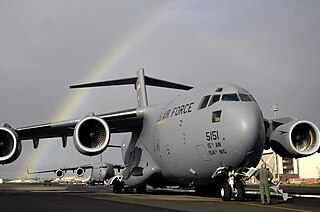
Hickam Air Force Base is a United States Air Force installation, named in honor of aviation pioneer Lieutenant Colonel Horace Meek Hickam. The base merged with the Naval Station Pearl Harbor to become part of the Joint Base Pearl Harbor–Hickam. The base neighbors Honolulu International Airport and currently shares runways with the airport for its activities and purposes.
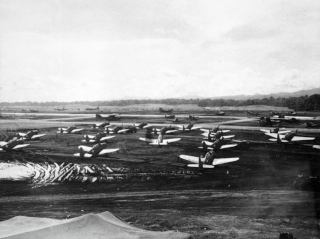
Cactus Air Force refers to the ensemble of Allied air power assigned to the island of Guadalcanal from August 1942 until December 1942 during the early stages of the Guadalcanal Campaign, particularly those operating from Henderson Field. The term "Cactus" comes from the Allied code name for the island. In 1943 the Cactus Air Force was subsumed into AirSols, a joint command of Allied air units in the Solomon Islands.

The South Pacific Area (SOPAC) was a multinational U.S.-led military command active during World War II. It was a part of the U.S. Pacific Ocean Areas under Admiral Chester Nimitz.

The 1st Marine Aircraft Wing is an aviation unit of the United States Marine Corps that serves as the Aviation Combat Element of the III Marine Expeditionary Force. The wing is headquartered at Camp Foster on the island of Okinawa, Japan. Activated in 1940, the wing has seen heavy combat operations during World War II, the Korean War and the Vietnam War.

Marine Aerial Refueler Transport Squadron 152 (VMGR-152) provides aerial refueling service to support Fleet Marine Force (FMF) air operations; and provides assault air transport of personnel, equipment, and supplies. The squadron, known as the "Sumos", flies the fixed-wing Lockheed Martin KC-130J aircraft. VMGR-152 is stationed at Marine Corps Air Station Iwakuni, Iwakuni, Japan and is part of Marine Aircraft Group 12 (MAG-12) and the 1st Marine Aircraft Wing.

Henderson Field is a former military airfield on Guadalcanal, Solomon Islands during World War II. Originally built by the Japanese, the conflict over its possession was one of the great battles of the Pacific war. Today it is Honiara International Airport.

Lieutenant Colonel Harold William "Joe" Bauer was a United States Marine Corps air group commander, fighter pilot and flying ace credited with destroying 11 Japanese aircraft during World War II. He was posthumously awarded the Medal of Honor for his actions as a fighter squadron commander during the crucial struggle for the control of the Solomon Islands at the Battle of Guadalcanal.
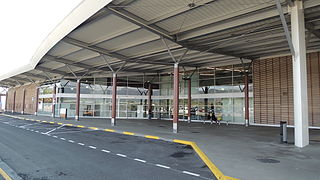
La Tontouta International Airport, also known as Nouméa – La Tontouta International Airport is the main international airport in New Caledonia. The airport is in the municipality of Païta, approximately 52 km (32 mi) northwest of Nouméa. La Tontouta International Airport serves international flights, while Noumea Magenta Airport, located 38 km south-east within the city of Noumea, serves domestic flights. The airport is regularly served by four airlines, including Aircalin, which is based at the airport. In 2017, 529,349 passengers used the airport.
South Pacific [SOPAC] Combat Air Transport Command (SCAT) was a joint command of US military logistics units in the Pacific Ocean theater of World War II. It contributed notably to the success of U.S. forces in the battles for Guadalcanal (1942–1943), New Georgia (1943), and Bougainville (1943–1945), as well as the Allied air campaign against Rabaul.

The 63rd Air Refueling Squadron, sometimes written as 63d Air Refueling Squadron, is a United States Air Force Reserve squadron, assigned to the 927th Operations Group at MacDill Air Force Base, Florida. It is a reserve associate of the active duty 91st Air Refueling Squadron. The squadron operates the KC-135 Stratotanker aircraft conducting air refueling missions.

The 64th Air Refueling Squadron is a United States Air Force air-refueling squadron assigned to the 22d Operations Group at McConnell Air Force Base, Kansas. As part of the Air Force's Total Force Initiative, the 64th is stationed at Pease Air National Guard Base, New Hampshire, where it is operationally controlled by the 157th Air Refueling Wing of the New Hampshire Air National Guard. The 64th is equipped with the KC-46 Pegasus.

Marine Transport Squadron 152 (VMR-152) was an air transport squadron of the United States Marine Corps that was responsible for the movement of personnel, equipment, and supplies. The squadron flew fixed-wing cargo aircraft to include the R4D Skytrain and the R4Q Flying Boxcar. The squadron saw combat during World War II and the Korean War with their most notable contributions coming during the Battle of Guadalcanal and during the Marine breakout during the Battle of Chosin Reservoir. The squadron was decommissioned in the late 1950s.

The 403d Operations Group is the operational flying component of the United States Air Force Reserve 403d Wing. It is stationed at Keesler Air Force Base, Mississippi.

Louis Bentham Robertshaw was an American football player and lieutenant general in the United States Marine Corps. He flew combat missions in World War II and the Korean War and flew an F4B Phantom II fighter in the Vietnam War as commanding general of the 1st Marine Aircraft Wing. He received three Distinguished Flying Crosses, 12 Air Medals, the Navy Distinguished Service Medal, and three Legion of Merit with Combat "V."

The first predecessor of the squadron was organized in 1940 as the 13th Transport Squadron. During World War II, as the 13th Troop Carrier Squadron, the squadron served in the South West Pacific Theater of World War II, earning two Distinguished Unit Citations, a Navy Unit Commendation and a Philippine Republic Presidential Unit Citation for its wartime actions. Its last assignment was with the 403d Troop Carrier Group at Nichols Field, Luzon, Philippines, where it was inactivated on 15 October 1946.
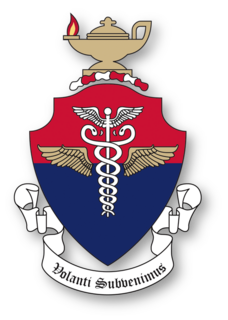
The United States Air Force School of Aerospace Medicine (USAFSAM) is the United States Air Force (USAF) organization focused on education, research, and operational consultation in aerospace and operational medicine. USAFSAM was founded in 1918 to conduct research into the medical and physiologic domains related to human flight, and as a school for medical officers trained to support military aviation operations, later coined as flight surgeons. The school supported early military aviation from World War I through the evolution of aviation and into the modern era. USAFSAM conducted medical research and provided medical support for the initial US space operations beginning in 1947 through the establishment of NASA in 1958. After the creation of NASA, USAFSAM continued to actively support civilian and military manned space missions through clinical and physiologic research. USAFSAM is one of the oldest continually operating school for flight surgeons and other operational medical personnel of its kind in the world. USAFSAM is located in Dayton, Ohio at Wright-Patterson Air Force Base, and is part of the 711th Human Performance Wing and the Air Force Research Laboratory (AFRL).
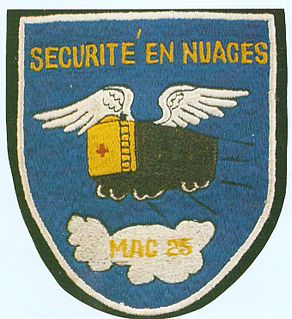
Marine Air Group (MAG) 25 was a United States Marine Corps combat air transport group that provided logistical support, including cargo and personnel transport and aeromedical evacuation, to forward units during World War II and the Korean War. During World War II it formed the nucleus of the South Pacific Combat Air Transport Command.
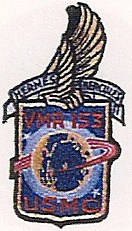
Marine Transport Squadron 153 (VMR-153) was a United States Marine Corps transport squadron that provided logistical support, including cargo and personnel transport and aeromedical evacuation, to forward units during World War II. It was under the command of Marine Aircraft Group 25 and the South Pacific Combat Air Transport Command (SCAT).
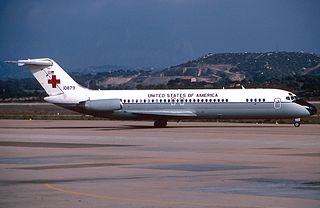
The 55th Aeromedical Airlift Squadron is an inactive United States Air Force unit. It was first activated during World War II as the 55th Ferrying Squadron. It deployed to Canada and managed a station on the ALSIB ferrying route.


















